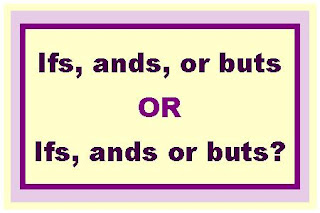The comma so perplexes me in writing that I think a whole
book could be written on the topic. It is used in so many different ways and its
usage is different depending on what you are writing and what you intend to
say. I’ve gone from being a comma-abuser to a comma-avoider to everywhere in
between.
Because of the complexity, I will concentrate on comma usage
in a particular minute instance, and maybe one day, I’ll have it mastered. This
week – the list.
I grew up hearing you always use a comma between the second
to last item in a list with three or more items and the conjunction (“and” or “or”)
appearing before the last item in the list (unless, of course, a semi-colon is
appropriate which is a whole other topic). Then when I became a paralegal, I
was told this was wrong – you should leave out that comma. And then I read
somewhere you should use the comma when writing lists in fiction but you should
leave them out when writing non-fiction. Even last week when reading a Harvard Business School case for a class, I noticed there were no commas between the last two items in lists in the text - "proving" the fiction vs. non-fiction distinction.
To solve this confusion, I turn to the “experts.” According
to A Pocket Style Manual, Fifth Edition,
on page 58, by Diana Hacker, you should follow the advice I received in grade
school of “use a comma between all items in a series of at least three,
including the last two.” Hacker acknowledges the paralegal no-last-comma camp
but indicates “most experts advise using [the comma] because its omission can result in
ambiguity or misreading.”
According to The
Associated Press AP Stylebook and Briefing on Media Law, 2009 Edition, you “do
not put a comma before the conjunction in a simple series” which appears to
consist of three similar items (p. 355). The Essentials of English, 6th Edition, by Vincent F.
Hopper, Cedric Gale, Ronald C. Foote, and Benjamin W. Griffith appear to agree
with Diana Hacker though it does admit it is “not absolutely essential” (p.
114). The Publication Manual of the American
Psychological Association, Sixth Edition, also agrees with the comma-always
mantra (p. 88).
So what will the Wordsy Woman do? Well, unless someone asks
me specifically to leave it out, I will insert a comma between the
second-to-last item and the “and” or “or” in my list of three items or more.


No comments:
Post a Comment